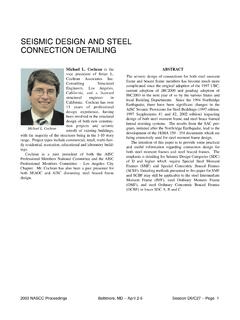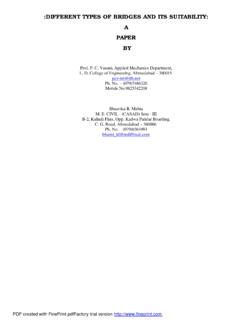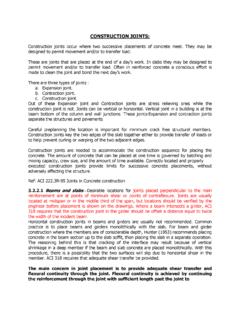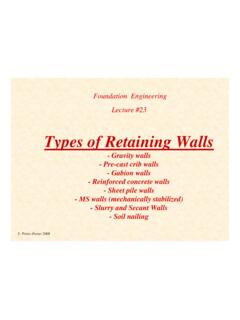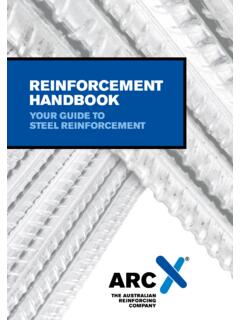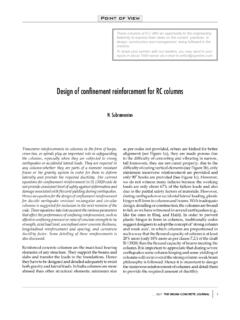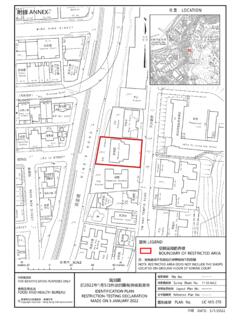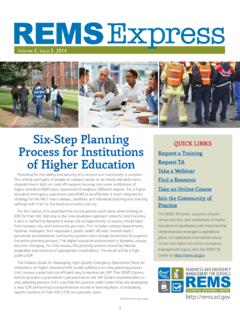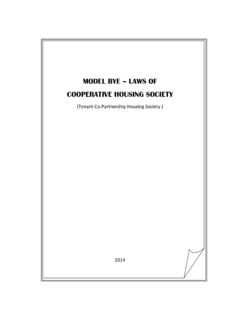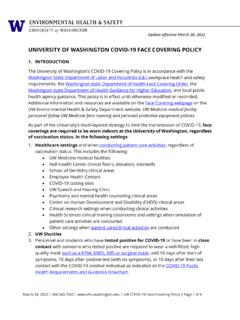Transcription of MULTI STOREY CAR PARKING - Structural Engineers
1 MULTI STOREY CAR PARKINGBY:KHAIRUNNUR BT MD SHAKRI NUUR LAILY BT KHAIRUDDIN A MULTI - STOREY car park or a PARKING garage is a building (or part thereof) which is designed specifically to be for automobile PARKING and where there are a number of floors or levels on which PARKING takes place It is essentially a stacked PARKING lot It is limited to 5 till 6 stories with the total capacity up to 500 cars per lot Apply multiple access and exit system to avoid traffic congestion in and outMULTI STOREY CAR PARKING Criteria for the quality MULTI STOREY car parks are;-safety in use-clear visibility- PARKING -space marking to enable drivers to remember the location of their vehicles-integration into the context of town planning-clear views to the outside-good natural lighting and ventilationMULTI STOREY CAR PARKINGGENERAL GUIDELINES Basement PARKING Appropriate for residential area, apartment, commercial complex, office complex and for area around airport that has building high control limit podium PARKING For medium and high density residential area, plus, office complex.
2 Ground level until level 4 are used for the PARKING area, while residential unitS, office and other functional spaces are located above the PARKING level Independent building for MULTI STOREY car PARKING For all building types that have large and adequate area for PARKING , such as low cost apartment, trade and city center, park and ride system at LRT station or railway station, bus station, institution, sport complex and mosque Normally built separately if the building function is different Roof top PARKING Appropriate for shopping complex (less that 5 stories) because it saves cost compared to basement parkingMULTI STOREY CAR PARKINGS ource: Department of Town and Country PlanningMULTI STOREY CAR PARKINGTYPES OF PARKINGFLOOR SYSTEMRAMPSSYSTEMMECHANICAL ELEVATOR/AUTOMATED PARKING splitslopingCONVENTIONAL PARKING / SELF PARKING systemtypesclearwayadjacentStraightcurve layout4560parallerperpendicular30 CONVENTIONAL PARKING RAMP SYSTEM1)Clearway PARKING Interfloor travel path completely separated from potentially conflicting PARKING unparking movements Provide safest movement with least delay Preferred for self park design Feasible for small garage sitesclearway ramp systemRAMP SYSTEM2) Adjacent PARKING Part or all of ramp travel is performed on access aisles Requires less area per PARKING stall Twofold use of travel paths Feasible for smaller land parcel More susceptible to traffic movement delays Has potential in causing accidentAdjacent- PARKING ramp systemsRAMP DESIGN1)
3 Opposed ramp design Vehicles rotate in the same direction Up and down ramps in opposite direction Required ramp surfaces to be opposed The operation is safer2) Parallel Up and down ramp slope in the same direction Ramp surfaces are parallel Vehicles must rotate in opposite direction Cheaper to constructopposed ramp designparallel ramp design parallel PARKING requires experience, confidence, and patience PARKING spaces (min ); meters long meters wide. Advantages Works well in extremely narrow, linear spaces Requires minimum pavement area Disadvantages Difficult maneuvering for most drivers Less than ideal visibility of adjacent traffic Inefficient use of on-street space PARALLEL PARKING layoutAngle 90 effective in low turnover rate or long term PARKING areas, the perpendicular, or 90 degree PARKING configuration is the most efficient and economical since it accommodates the most vehicles per linear meter. Standard dimensions for this configuration are: DescriptionDimensionParking space meters PARKING space length6 meters Driving aisle width (2-way) 7 meters Two rows plus aisle width 19 meters Vvehicles per 100 linear meter double row 82 Degree PARKING Dimensions and GeometryAdvantages Works well with either one-or two-way aisles Handles the most vehicles per square meter of pavement Handles most vehicles per linear meter Disadvantages Requires widest area Difficult maneuvering for some drivers Two-way traffic can create some visibility problems 90 Degree PARKING PatternAngle 90 Angle 60 -ideal for a fast turnover rate or predominantly short term use-often offset by difficulties of inefficient circulation patterns and one-way aisles Standard dimensions for this configuration are.
4 DescriptionDimensionParking space width meters PARKING space length6 meters Driving aisle width (1-way) meters Two rows plus aisle width meters Vehicles per 100 linear meter double row Degree PARKING Dimensions and Geometry Advantages in and out of PARKING spaces Good visibility Lends itself to either one-or two-way aisles Most common short term PARKING configuration Disadvantages Requires more pavement per vehicle than perpendicular configuration Handles less vehicles per linear meter 60 Degree PARKING One-way and Two-way Patterns Angle 60 Angle 45 The 45 degree angled PARKING configuration displays similar benefits and limitations as the 60 degree. Standard dimensions for this configuration are: DescriptionDimensionParking space width PARKING space length 6 meters Driving aisle width (1-way) meters Two rows plus aisle width14 meters Vehicles per 100 linear meter double row Degree PARKING Dimensions and GeometryAdvantages Reduced width requirements for layout Easy maneuvering in and out of PARKING spaces Good visibility to the rear Disadvantages Doesn't work well with two-way aisles Requires more pavement per vehicle than perpendicular PARKING configuration 45 Degree PARKING PatternAngle 45 Angle 30 Standard dimensions for this configuration are.
5 DescriptionDimensionParking space width metersParking space length6 meters Driving aisle width (1-way) 7 meters Two rows plus aisle width 19 metersVehicles per 100 linear meter double row Degree PARKING Dimensions and GeometryAdvantages Easy PARKING Reduced width requirements for layout Disadvantages Requires the most pavement per vehicle Doesn't work well with two-way aisles 30 Degree PARKING Pattern Angle 30 Types of ramp1)Straight ramp Usually rectangular shaped with ramp well along the structure s longer side dimension more horizontal distance is required to satisfy ramp grade criteria than accommodate vehicular movement between ramp ends Requires less floor area and simple to construct Economical space on lot that is long and narrow Cause difficulties to get on and off straight ramp (Sharp turn) Having two ways circulation lanes on PARKING floor may be hazardous Up and down circulation lanes intersect on the PARKING floor unless the floor area is so large that each circulation can be kept within its own half on one-way lanescurve ramp Single surfaces that permits vehicles to travel on a continuous helical path between PARKING levels Movement;Up-counterclockwiseDown-counter clockwiseEntrance and exit in the side Opposite side of ramp oil Directly above each other on succeeding floor Should be clearway type Continuous-360 of rotation between two PARKING levels Located near corners of rectangular structure to minimize floor space loss but required more space than straight ramp.
6 (fit narrow site but waste more spaces) costly to construct Offer better traffic operation by providing gradual turning as compared to sharp turning movement usually required at ends of straight ramp Super elevation at ends of straight ramp create undesirable wrapping of floor areas No crossing of up and down traffic, even at PARKING floor connection Each traffic stream confined to its own ramp all the way from the top to bottom of the building Diameter of ramp is controlled by required turning radiuS (min 45 ft) Driver have a clear view each way even there is a crossing of traffic at each PARKING floorFunctional plan for twin-spiral garageFLOOR SYSTEM1) SPLIT-LEVEL OR STAGGERED FLOOR SYSTEMS Floor levels in one section is staggered vertically by one half story from those in adjacent sections Applicable to small, high-cost sites where maximum use of space must be achievedAdvantages Construction is relatively simple The design fits well on rectangular sites Efficient in terms of floor space per vehicle PARKING stallDisadvantages Frequent conflicts may arise between circulating traffic and PARKING and un- PARKING vehiclesSplit system Two-way staggered-floor ramp systemTandem staggered-floor ramp systemThis staggered-floor system provides PARKING on level floors and desirable one-way traffic flow-COMMON TYPET hree-level staggered-floor ramp systemFLOOR SYSTEM2) SLOPING-FLOOR SYSTEMS Consist of sloping levels (full width ramp/continuous ramp)
7 Contains two adjacent PARKING modules tilted in opposite directions Well-suited to self-park operationsAdvantages The relatively flat floor slope permits comfortable PARKING and pedestrian walking Each entering customer has an opportunity to park in the first available space as PARKING is adjacent to the interfloor circulation system Floor-to-floor travel distance is greater in sloping-floor garages than in other types of ramp garagesDisadvantages Cause congestion during peak out-bound movements Basic sloping-floor conceptPlan view of sloping floor systemsSloping floor system with crossover ramp of mid point Double sloping-floor system with midpoint crossoverAUTOMATED PARKING Automated PARKING is a method of automatically PARKING and retrieving cars typically using a computerised system of pallets, lifts and carriers Most suitable on expensive sites and where land is very limited-too small for economical development with a ramp PARKING advantages :-increase capacity ; high space utilization due to lower ceiling height, dense PARKING , and reduce space width-no ventilation or HVAC required; saving utility costs-eliminates stairs, elevators and fire exits-enhance safety and security-typically requires less building volume and less ground area than a conventional facility with the same capacityAUTOMATED PARKING Disadvantages : -cost.
8 Operation and maintenance Many Structural and functional types of automated mechanical systems exist, such as :-underground systemsas part of the building foundation -above gradewhere they can match neighboring buildings in architectural appearanceSTANDARD AND REGULATIONRamp break over angle Measure ability of the car to break over the steep ramp either climbing or descending without scrapping(Min 10 ) Can be altered through design techniques Transitional blend top and bottom of ramps composed of two or more break point can multiply the steepness with workable break angles beyond the normal capacities of cars or driver Having pad of asphalt or concrete each side of break point so that the cars having low break over angle can negotiate potential critical points without scrappingAngle of departure Min 10 To reduce incident of tailpipe and rear bumping draggingAngle of approaches Min 15 Angle of approachesAngle of departureRamp slopes Max 15% For slopes over 10%.
9 Transition at least 8 feet long should be provided at each end of the ramp at one half the slope of the ramp itselfRamp grades transition Min 12 foot long = 1/2 of ramp gradeRamp widthOne way straight ramp-min 12 feetTwo way straight ramp-min 22 feetCircular ramp-min 14-18 feetRamp radius Single lane helical ramp-min 32 -37 feet Must kept min to conserve space and reduce travel distance Very sharp can cause dizzyRamp turn super elevation inch/foot of ramp width at sharpest turning Ramp curves not too steeplya) Slow driver-difficult to keep way from inside edge of ramp pavementb) Fast driver-encourage to speed greater than conditions of grade and sight distance safety permitSTANDARD AND REGULATIOND riveway exitsa) Ramp driveway exit rising up to public sidewalk have transition section min 16 feet long at almost level before intersecting the sidewalk Prevent hood of the car from obscuring the driver s view of pedestrians on walkb) Property line wall Must not interfere with the driver s view of pedestrian on public side walk.
10 If exit driveway is parallel and adjacent to the property line that extends all the way to side walk, edge of the driveway should physically establish by curbing or railing. min 6 feet from the grades Computed by :floor to floor height x 100_____Ramp length Max ramp grades: a) self park design-not exceed 15 %-not exceed than 10% if had a pedestrian walkway on vehicles rampb)sloping floor self park design-ramp grades max 4%-angle PARKING 60 -minimizes gravity roll back of vehiclesSTANDARD AND REGULATIONRamp appearanceArchitectural and optical effect Ramp wall -Painted with stripes contrasting to wall color-Parallel to ramp surfaces or at steeper angles-Use paint marking in between vertical column and travel way-Built Structural features with architectural lines parallel or perpendicular to ramp surfaces Ramp structures-Open ; to provide sight distance and reduce closed in impression Ramp illumination-Wall opening are restricted-distract the driver s view-Artificial lighting should take form of diffused illumination-Reflector should pointed away from the direction of travelSigns and Wayfinding Color-coding, numbering, visual cues, music, and even machines for marking your ticket with your exact location to locate your car for easy retrieval Locate signs in areas where driver can read in a timely fashion Clear, simple, and direct messages Floor coding can be useful Signage should locate all major internal pedestrian access points as well as external major roads and buildingsVehicle controlFee collection Fixed or variable charged pay on exitBarrier capacity 2 barrier types available-Rising arm-Rising kerb Entry barrier400 vehicles/hour Exit barrier250 vehicles/hourLighting Services illumination for public should be (lux).
